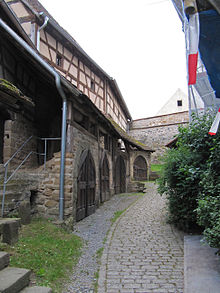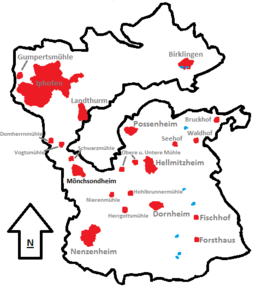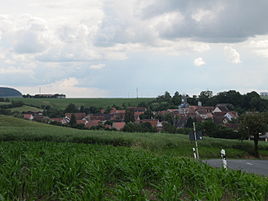Mönchsondheim
|
Mönchsondheim
City of Iphofen
Coordinates: 49 ° 40 ′ 5 ″ N , 10 ° 16 ′ 44 ″ E
|
|
|---|---|
| Height : | 261 m |
| Incorporation : | January 1, 1972 |
| Postal code : | 97346 |
| Area code : | 09326 |
|
Location of Mönchsondheim (bold) in the Iphöfer municipality
|
|
Mönchsondheim is a district of the city of Iphofen in the Lower Franconian district of Kitzingen .
Place name
The etymology of the place name with the components monk, -sond and -heim indicates the origin and development of the settlement. The ending -heim refers to the foundation in the time of the Frankish conquest . The place was probably a branch of the royal court of Iphofen. Sund -heim lay south of it. This is probably where the middle part of today's name comes from. The first constituent monk comes from the fact that the village belonged to monasteries from the 12th to the 19th century.
history
Places with the ending -heim refer to a foundation at the time of the Franconian conquest .
The place Suntheim was mentioned for the first time in 1100 in a document of the St. Stephan monastery in Würzburg . At the end of the 13th century, the village came into the possession of the Ebrach monastery . Although the monastery ruled the village until secularization in 1803, the residents adopted the Protestant denomination. In 1533 they submitted to the protection of the Margraves of Brandenburg-Ansbach . This patronage and the sovereign rights of the monastery repeatedly led to disputes.
When Ebrach Abbey was dissolved in 1803, the place changed from electoral Bavarian to margravial and then French rule. In 1806 Mönchsondheim finally came to the Kingdom of Bavaria .
In 1972 the place was incorporated into Iphofen.
geography
Mönchsondheim is located in a depression in the southwestern Steigerwald foreland. The place is traversed by the Breitbach , in the northwest of the place the Moorseebach and at the southeast end of the village the Kirchbach flows. The place belongs to the Hellmitzheim Bay . This pushes itself deep into the Steigerwald and opens westwards to the Main valley. The Franconian Marienweg runs through the village .
In the southeast of the district of Mönchsondheim lies the Bulach desert . The village was subject to a ten-year fee to the Münsterschwarzach monastery . The settlement must have been abandoned before 1283. The reasons for this are unclear.
Culture and sights

Architectural monuments
Fortified church
It was expanded to a fortified church in the 15th century.
St. Boniface
The parish church of St. Bonifatius is located within the Gaden church castle . For the first time in 1224 a previous building of the house of God was named “capella in suntheim”. In 1638 the church tower of the previous building collapsed. The church could no longer be used and the service took place in the cemetery church for 50 years. Finally, in 1688, after the demolition, the new building of today's church began. On September 7, 1690, Dean Johann Teuerlein from Uffenheim inaugurated the new building.
The wooden pulpit from 1613 was taken over from the old church. The altar of the choir tower church was built at the time of construction. The church received its baptismal font in 1717. As part of the overall renovation of the fortified church, a fundamental renovation of the dilapidated structure and interior renovation took place in 1977.
Cemetery church
The chapel on the church, mentioned for the first time in 1597, no longer exists. Today's cemetery church was built in 1722/1723.
Former town hall
The former town hall of the municipality was used as a meeting place for the municipal administration until 1972. Today it is part of the fortified church museum and delimits the ensemble around the church in the south. The town hall was originally built entirely from half-timbering, but was given a brick ground floor in the 19th century. Particularly noteworthy is the densely crafted half-timbering, which since a renovation in the 1990s shines again in the colors of the early modern era.
Fortified Church Museum
In addition to the fortified church, the open-air museum also includes the surrounding buildings of the typical Franconian village center. In the rooms of the fortified church, visitors are informed about village handicrafts and agriculture. The other buildings such as the town hall, school, inn and farms are used for exhibitions.
Economy and Infrastructure
traffic
The district road KT1 runs through Mönchsondheim. From Bundesstraße 8 , exit Markt Einersheim, the village is reached after 3 kilometers via Mönchsondheimer Straße.
The place is connected with the Kirchenburg-Express from Iphofen to the railway line Nuremberg – Würzburg .
Public facilities
The community has a volunteer fire brigade .
literature
- Johann Kaspar Bundschuh : Münchsontheim . In: Geographical Statistical-Topographical Lexicon of Franconia . tape 3 : I-Ne . Verlag der Stettinische Buchhandlung, Ulm 1801, DNB 790364301 , OCLC 833753092 , Sp. 679 ( digitized version ).
- Karl Kolb: Fortified churches and fortified churches in Franconia . Echter Verlag, Würzburg 1977, ISBN 3-921056-16-0 .
- Gottfried Stieber: Mönchs-Sontheim . In: Historical and topographical news from the Principality of Brandenburg-Onolzbach . Johann Jacob Enderes, Schwabach 1761, p. 594-595 ( digitized version ).
Web links
Individual evidence
- ↑ a b c Reinhard Hüßner: Mönchsondheim . In: Jesko Graf zu Dohna (Ed.): In the footsteps of the Counts of Castell . Vier Türme GmbH, Benedict Press, Münsterschwarzach 2004.
- ↑ Susanna Berger: The Iphöfer districts . Mönchsondheim. In: District Kitzingen (ed.): Art and culture guide through the district Kitzingen . 2nd Edition. Color printing Brühl, Marktbreit 1993.
- ↑ a b c Andreas Brombierstäudel, Hans Seitz: Mönchsondheim . In: Deanery Markt Einersheim . Evangelical parishes in the Steigerwald. Verlag der Ev. – Luth.Mission, Erlangen 1978, ISBN 3-87214-092-2 .
- ^ Fritz Ortner: Illustrated guide through market Einersheim and its history . Ed .: Markt Markt Einersheim. Hügelschäffer printing works, Mainbernheim 1986.
- ↑ Kirchenburg-Express ( Memento of the original from September 24, 2015 in the Internet Archive ) Info: The archive link was inserted automatically and has not yet been checked. Please check the original and archive link according to the instructions and then remove this notice. PDF 3.5 MB




